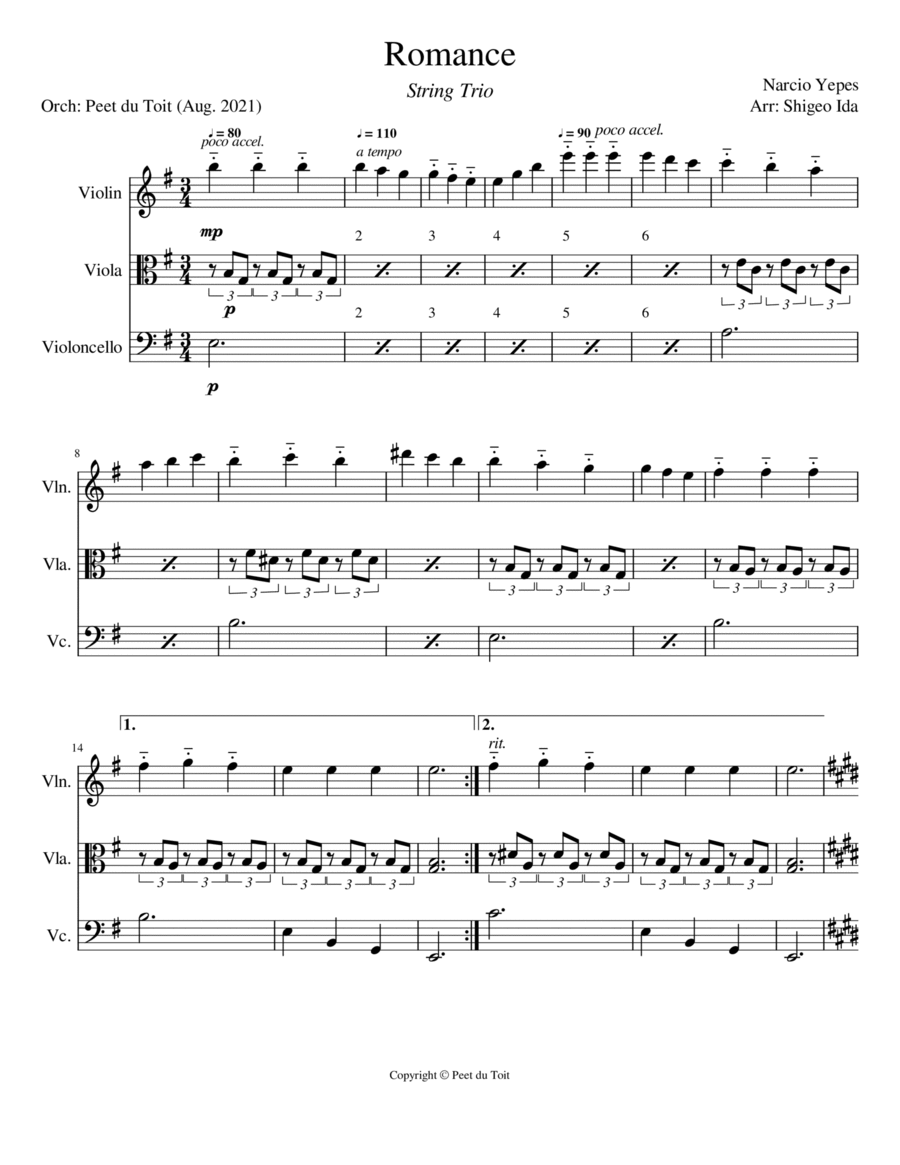String Ensemble,String Trio Cello,Viola,Violin - Level 2 - Digital Download SKU: A0.802693 Composed by Anon. or Fernando Sor, or Narciso Yepes. Arranged by Shigeo Ida & Peet du Toit. Contemporary. Score and parts. 6 pages. Peet du Toit #6513457. Published by Peet du Toit (A0.802693). Romance Anónimo (Anonymous Romance) is a piece for guitar, also known as Estudio en Mi de Rubira (Study in E by Rubira), Spanish Romance, Romance de España, Romance de Amor, Romance of the Guitar, Romanza and Romance d'Amour among other names.Its origins and authorship are currently in question. It is suspected of originally being a solo instrumental guitar work, from the 19th century. It has variously been attributed to Antonio Rubira, David del Castillo, Francisco Tárrega, Fernando Sor, Daniel Fortea, Miguel Llobet, Antonio Cano, Vicente Gómez, and Narciso Yepes. The Anónimo (anonymous) part of its name has been incorporated over the years due to this uncertainty. The question of authorship has probably been propagated by three main reasons: the lack of claim by its true author, the desire to avoid paying copyright fees, and the desire of publishing companies to claim the lucrative copyright of this world-famous piece.The style of the piece is that of the Parlour music of the late 19th century in Spain or South America, having a closed three-part form: the first in the minor key and the second being in the major key, with the third being a restatement of the first.Narciso Yepes (1927 - 1997) interpreted and is listed as the author of the piece in René Clément's 1952 film Jeux interdits (Forbidden Games). The popularity of the film gave the piece worldwide fame. Yepes currently has the copyright of this composition in Spain although recordings and manuscripts of this song predate 1952. Newer publications show Yepes as the arranger and the piece being of anonymous authorship, or authored by Fernando Sor.The official statement from Narciso Yepes and the Yepes heirs is that Narciso Yepes, being a young boy, originally composed the piece for his mother when he was about seven years old (c.1934) and soon thereafter performed it between acts at the Teatro Guerra, in Lorca, Spain. Some time later, he recounts, when he was thirteen years old he attended a performance in Valencia and heard his composition performed by another guitarist, who indicated the authorship as anonymous. Yepes contends that the melody had been plagiarized (with some changes to the arrangement) by someone who, he assumes, must have attended that first performance. However, Yepes was born 1927 and cannot be the author of the work, since it was already recorded in 1900 and published before 1925 (possibly 1913) by J.A. MEDINA e HIJO; and in 1919 in themethod of Pedro Mascaró y Reissig, etc. Vicente Gomez (1911-2001) published it and performed it in 1941 in the Hollywood movie Blood and Sand with Tyrone Powerand Rita Hayworth, also attributing authorship of the song to himself. Anyway, the piano arrangement of the brilliant Shigeo Ida caught my attention and I decided to rework it somewhat into this trio for strings. Enjoy!
